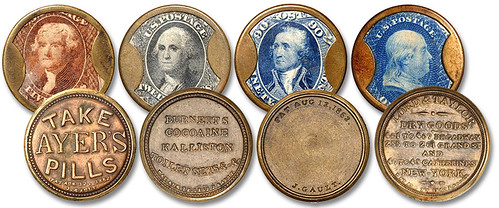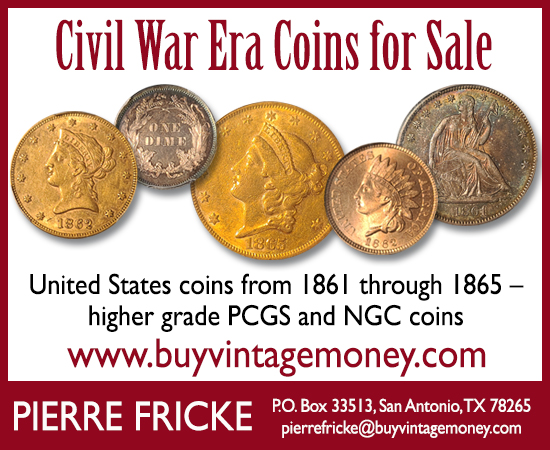
PREV ARTICLE
NEXT ARTICLE
FULL ISSUE
PREV FULL ISSUE
THE LAST ENCASED POSTAGE STAMP ISSUERDave Bowers beat me to it - I was already planning to mention the numismatic connection to Lord & Taylor, the recently bankrupted store chain. -Editor

Lord & Taylor, the famous fashion retailer, is no longer with us, or at least not in its usual form. On August 3 the firm announced Chapter 11 bankruptcy protection and stated it planned to close all 24 of its stores. Numismatically, Lord & Taylor is well-remembered for its issuance of encased postage stamps. In the second week of July 1862, with no silver or gold coins in sight, and the channels of commerce awash in paper bills, even copper-nickel cents were hoarded. It was impossible to find a coin to buy a newspaper, get a haircut, or take a ride on a horse-drawn car. Breaching the gap, many merchants, towns, and others issued tickets imprinted with values from one cent onward; paper money scrip notes with three cents and five cents were the most popular, but other values went up to a dollar or more. In time, many merchants issued bronze tokens, the size of a cent, which served for that value. In the meantime, both the Confederate and Union were issuing more and more paper money. On February 25, 1862, the first “greenback” bills were authorized, these being called such because of the color of the reverse. By June 1862, over $100,000,000 of greenbacks flooded the North. Silver and gold coins sold at increasing premiums, with changing rates published in the daily papers. In New York City in July, the premium on silver coins was 5% to 6%, meaning that it took $105 in greenbacks to buy $100 in federal coins. On July 11, it took $130. Horace Greeley, proprietor of the New York Tribune, suggested on July 9, 1862, that ordinary postage stamps could be used as change, these being conveniently pasted onto the bottom of a small piece of paper, the top being folded over. The idea achieved some popularity, mostly by taking the form of loose postage stamps in small envelopes imprinted on the front with a value such as 25¢. Others took postage stamps and pasted them to small pieces of cardboard. The idea caught on, and the Treasury Department began experimenting with such. On July 14, Secretary of the Treasury Salmon P. Chase suggested to Congress that government stamps be made official as legal tender for small transactions. In the meantime, Treasurer Francis E. Spinner had pasted postage stamps onto sheets of Treasury Department letterhead paper, cut down, and bearing his signature, together with stamps amounting to 5¢, 10¢, 25¢, and 50¢. He contacted the local post office and made an arrangement that stamps that were damaged should be redeemed at face value for new ones. In response to Chase’s request, the Act of July 17, 1862, provided for the use of postage stamps for monetary transactions, including that by August 1 stamps would be exchangeable for Legal Tender “greenback” notes at all Treasury offices. They were also receivable for government obligations in amounts under $5, but they were not given official legal tender status, despite the Chase’s request. In August 1862 Postage Currency notes were issued, featuring the same designs as postage stamps but in the shape of small pieces of paper money with additional inscriptions and with perforated edges. At first these were distributed to Army paymasters, then in September to the general public. By early 1863 about $100,000 of these flimsy little bills reached circulation per day. The great public confusion regarding the use of stamps and early issues of Postage Currency is delineated at length in The Standard Catalogue of Encased Postage Stamps, by Michael J. Hodder and Q. David Bowers, 1989, created in part with advice from John J. Ford, Jr., who encouraged the project. Now long out of print, copies of this book can be found on the internet. During this time 31 different merchants signed up to advertise on encased postage stamps, invented by John Gault. Early issues bear Gault’s own imprint and, beginning later in the year 1862, after he joined Joseph Kirkpatrick in the formation of Kirkpatrick & Gault, 1 Park Place, the name of the new company was used.
To read the complete article, see:
Here's a little history of the firm. -Editor Lord & Taylor, the first department store established in the United States, is officially going out of business, ending a nearly 200-year run. The bankrupt company announced Thursday that all of its 38 remaining stores and website have begun liquidation sales — a reversal from last week's decision to keep 14 locations open. The company was once a mainstay of high-end fashion. Lord & Taylor opened its first store in New York in 1826. According to its website, Lord & Taylor was created by English immigrants Samuel Lord and George Washington Taylor when they opened their first store on the Lower East Side of Manhattan nearly 200 years ago. The store would grow and relocate six times over its first 80 years, moving into its flagship Fifth Avenue store near Times Square in 1914. By then the company had already been publicly traded for 10 years.
To read the complete article, see

Wayne Homren, Editor The Numismatic Bibliomania Society is a non-profit organization promoting numismatic literature. See our web site at coinbooks.org. To submit items for publication in The E-Sylum, write to the Editor at this address: whomren@gmail.com To subscribe go to: https://my.binhost.com/lists/listinfo/esylum All Rights Reserved. NBS Home Page Contact the NBS webmaster 
|